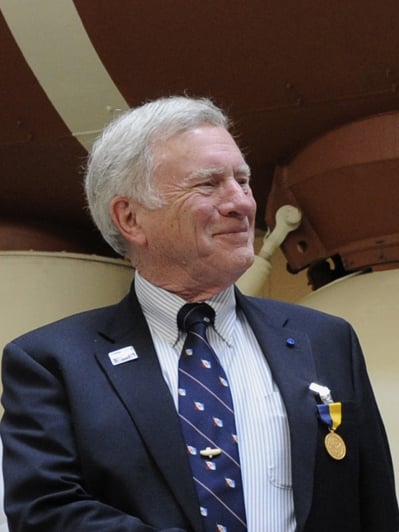When Christopher Columbus came upon the New World in 1492, his historic crossing of the Atlantic Ocean had taken five weeks. Since then various records have been set for traversing the Atlantic. There is the famous "Blue Ribband" award established in the mid-1800s for passenger vessels that made the fastest crossing times. The SS United States holds this prize with a 1952 crossing in three days, ten hours, and 40 minutes, at 35.5 knots.
Specialized high-speed vessels have gone even faster. The powered record is held by the Italian ship Destriero. In 2009 she crossed at 54 knots, doing the voyage in less than two and a half days. The fastest sailing boat took a little over three and a half days at a speed of 33 knots.
At the other end of the speed spectrum is a truly remarkable seven-month crossing recently made by a specially configured unmanned submersible, the Scarlet Knight (RU-27), operated by Rutgers University. It took 221 days, from April to December 2009, for the craft to make the 4,500 miles from New Jersey to the vicinity of Baiona, Spain (coincidentally, the same port where Columbus' ship Nina returned in 1493).
The Scarlet Knight is a type of autonomous unmanned vehicle (AUV) called a glider. Instead of being driven by a conventional propeller, a glider "flies" underwater. To dive, it takes on a small quantity of water and then slowly glides to a predetermined depth. At that point, a pump discharges some water to make the submersible positively buoyant so it can glide back up toward the surface.
Looking somewhat like a small torpedo with wings, the Scarlet Knight weighs in at about 135 pounds and is almost 8 feet long. Her lithium battery provides 300 days' worth of power-a comfortable margin for her record-setting voyage.
During the Atlantic crossing the glider operated between depths of 60 and 600 feet, with the dive cycle being repeated 10,000 times. Frequent excursions to the surface permitted the Rutgers team to monitor the AUV's position, direct course changes, and download scientific data.
The Scarlet Knight is of a type known as a "Slocum glider," a vehicle that has been modified for transoceanic missions. The original concept for this glider type goes back to the late 1980s, when noted oceanographer Henry Stommel at Woods Hole Oceanographic Institution (WHOI) proposed it. He saw it as an economical means for conducting research over large ocean areas using multiple low-cost vehicles. Stommel picked the name "Slocum" to honor the 19th-century New England sea captain Joshua Slocum, who in 18951898 became the first man to sail solo around the world.
The first practical underwater glider was designed and built by Stommel's former WHOI colleague, Douglas Webb, an engineer who had left the institution in 1982 to form Webb Research. His first successful Slocum-glider prototype was tested in 1991. Now called Teledyne Webb Research, Webb's company is the largest single producer of glider-type AUVs.
The Scarlet Knight is one of 23 gliders operated by Rutgers University's Coastal Ocean Observation Laboratory (RU COOL). There was a 24th that was lost at sea near the Azores in 2008 during COOL's first attempt at a transatlantic crossing. Damaged by a shark, captured by some critter, or perhaps laid low by extreme biofouling? The cause of the sinking is unknown.
As of April 2010, Rutgers' fleet of Slocum gliders had spent 3,371 days at sea traveling some 46,000 miles. The university's glider AUV program, begun in 2003, is now the biggest in the world. Rutgers gliders have operated in ocean environments as diverse as the Antarctic and the Gulf Stream.
Although Rutgers is the largest operator of gliders, other oceanographic institutions from Britain to Australia now employ various types of them as well. In the United States, glider operators include the Mote Marine Laboratory (using a Slocum glider), the University of Washington (using the Seaglider), and the Scripps Institution of Oceanography (using the Spray). Depending on the model and its configuration, operating depths can be as great as 11,000 feet-a depth reached in 2006 by the University of Washington's Deep Glider.
While many excellent AUVs are in development and in operation today, the major advantages of gliders in particular are their low cost, high portability, and long mission times. They are excellent for seagoing oceanographic research tasks that do not require the presence of humans on site. Fleets of these unmanned vehicles will greatly amplify and supplement what can be done with conventional oceanographic ships. There never will be enough research ships and scientists to do comprehensive studies of the World Ocean in any sort of reasonable time. The increasingly extensive use of gliders has proven the utility and reliability of these vehicles-and now, the Scarlet Knight's historic Atlantic crossing serves as their latest milestone.




